Raptors can be quite innovative in their hunting techniques.
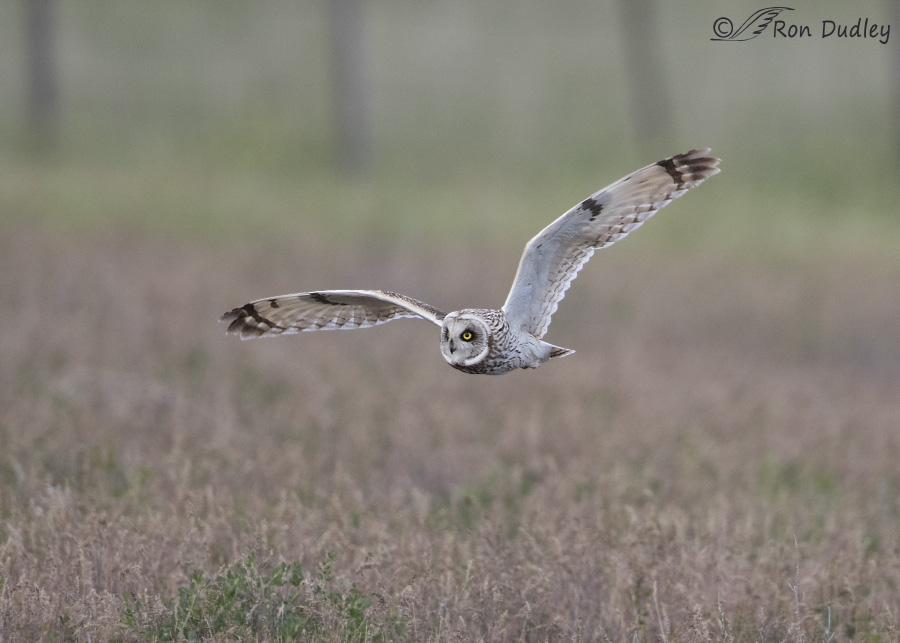
1/2000, f/5.6, ISO 1000, Canon 7D Mark II, Canon EF 500mm f/4L IS II USM + 1.4 tc, not baited, set up or called in
Two mornings ago this Short-eared Owl was hunting low and slow in a pasture in northern Utah. The fence posts enclosing the pasture can be seen at the top of the frame. It would hunt on the wing for a while and then return to one of the posts near where I was parked on a road and hunt from there.
But while it was hunting in flight it often wasn’t hunting randomly.
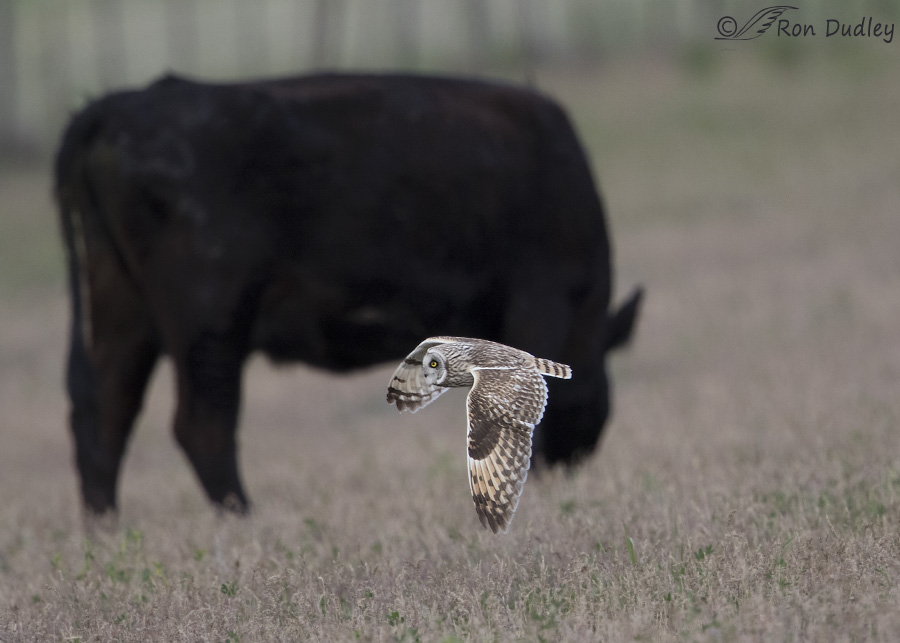
1/2000, f/5.6, ISO 1000, Canon 7D Mark II, Canon EF 500mm f/4L IS II USM + 1.4 tc, not baited, set up or called in
There was perhaps 100 dispersed cows in the large pasture and the owl was obviously hunting voles or other prey that might get stirred up by the grazing cows as they moved. The bird in flight would approach one of the cows quite closely and then move on to another cow. And another. One time I saw it dive on prey very near a cow but it was so far away I couldn’t tell if it was successful.
My first close introduction to raptors as a young kid was when I was driving tractor on the Montana farm. Buteos of several species would follow the tractor very closely as they hunted for rodents and rabbits stirred up by my plow. Driving tractor was boring for me so I entertained myself by paying very close attention to the hawks – they were fascinating to watch. But that distraction didn’t make for very straight plow lines in the fields and I would often miss spots with the plow (we called those spots “skips”) where weeds would later grow tall. My Dad was not amused…
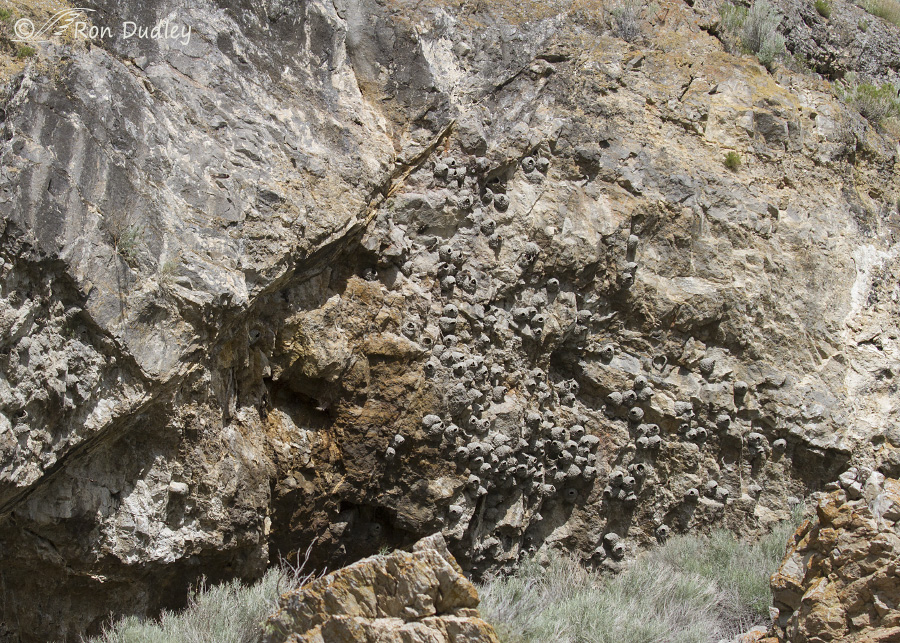
On the same morning I spent some time watching this colony of Cliff Swallows on a vertical cliff (only some of the nests in the colony can be seen here). Most of the time the birds were undisturbed as they went about their daily routine of hunting insects and returning to their nests. But as I was watching a few of the nests through my lens the birds suddenly emerged from them in huge numbers, obviously in distress.
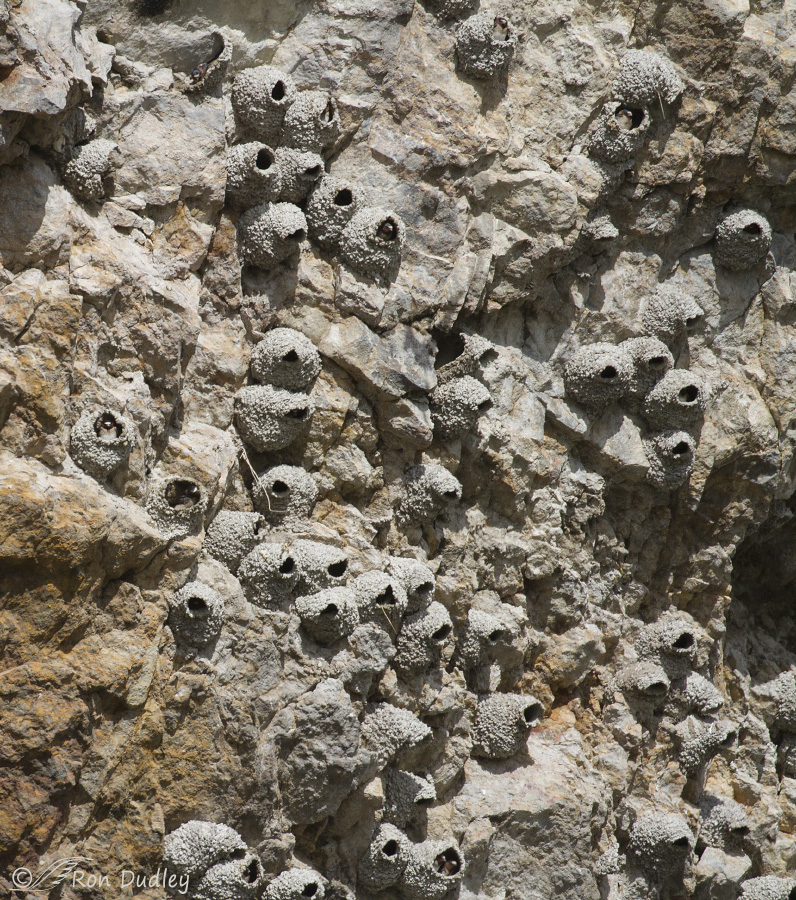
At first I didn’t know why they were upset but as soon as I looked away from my lens I saw an adult Red-tailed Hawk flying as slowly as it possibly could (wings flapping furiously to stay airborne) in front of the cliff face and very close to the nests (I never got any shots of it in flight). It did that twice and then…
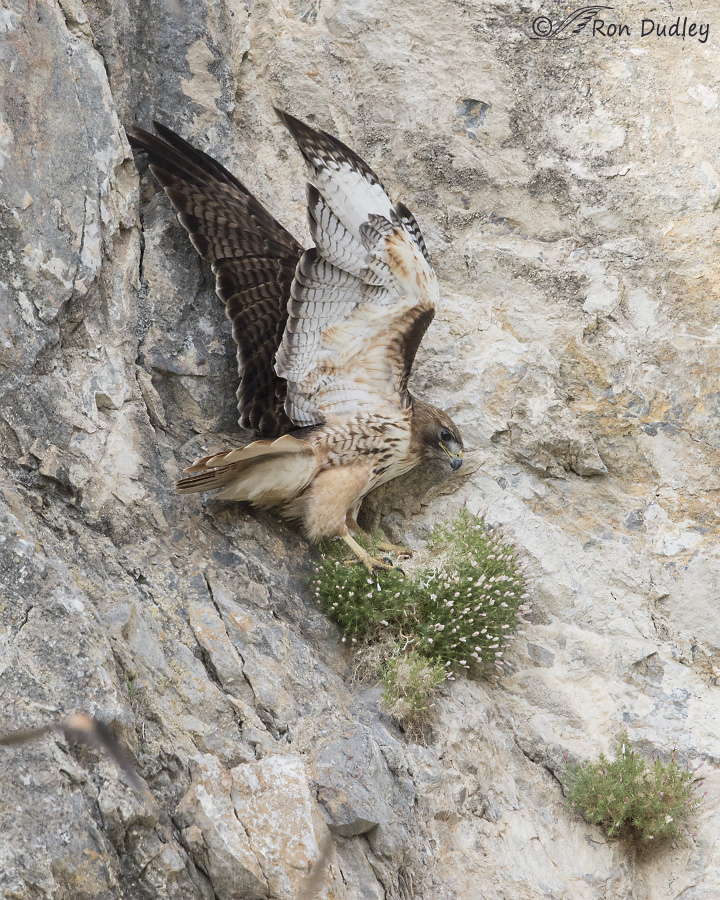
1/1250, f/6.3, ISO 500, Canon 7D Mark II, Canon EF 500mm f/4L IS II USM + 1.4 tc, not baited, set up or called in
it flew to a nearby portion of the cliff that was at an angle to the cliff face the nests were on and landed very precariously on a flowering plant growing out of the vertical cliff. The swallows were not happy about the presence of the hawk and constantly harassed it (one of them, out of focus, can be seen at lower left). Once the hawk stabilized itself on the perch I could see that it was obviously watching the cluster of nests in front of and below it.
I’m convinced the hawk was hunting swallows. I’m sure it couldn’t catch a healthy adult swallow but perhaps it was watching for unfortunate fledglings that fell out of the nest or failed in their first flight. Small birds aren’t normally part of the diet of red-tails but like many predators they’re opportunistic feeders and after all, food is food.
These were hunting behaviors I’d never noticed before from any raptor and I thought it was pretty unusual to see two of them on the same morning.
Ron


Well, I LOVE the photos and the information that you all have added to these great shots. I have to remind myself to “look up” sometimes. This blog is a constant reminder of that and I so appreciate it.
Now I guess I will just try to work through the fact that the scrub jay has taken and eaten all the dove eggs around my yard….all eleven of them. Nature!!!
Thanks for the beautiful shots.
Ron, the image of the adult RTHA is the best I have seen. All the feather detail and you captured its intensity. With that concentration it must have been hunting and a tasty fledging or inattentive adult would be just fine. Thanks so much.
You’re right, Diana, there is a lot of feather detail under that wing. Thank you.
That tractor driving sure prepared you for this career.
Then I should be a HIGHLY trained bird photographer, Karen. For a few years it seemed like I lived on that darned tractor (and swather).
Your father would have disowned me. I am pretty certain there would have been more skips than straight line.
Love that your open eyes and mind came up trumps this morning (again).
Bird-brained? I should be so lucky…
My father almost disowned ME a time or two, EC. You often can’t see skips until the weeds have grown and by then it’s too late. And each of those weeds produces thousands of seeds. Heaven help me if they were Canadian Thistle!
Very interesting. I did not think RedTail would bother with swallows. but like you said. food is food.Must be wonderful getting out these last few days. This is my favorite weather in Utah. It keeps the air fresh and clean and the smell of the fields after rain is wonderful. I hope to get out soon, we have a few days off.
I hope you can get out soon, April – you certainly deserve it. I remember when I was teaching and it seemed like every darn time I had a day off the weather was gloomy. I wish you the weather you prefer while you’re “out there”.
Those swallow nests represent so much work! One small beakful of mud “adobe” mix at mix daubde on at a time. We called any and all “skips”, of any kind, “holidays”..,,
Patty, according to BNA Online each Cliff Swallow nest consists of 900-1200 mud pellets, each delivered on an individual trip to the nest. Makes me tired just to think of it!
This is yet another time when one has to respect the quality of a ‘bird brain’. These raptors are obviously smart. I feel badly for the Cliff Swallows, even though I know that predators are always a part of their lives. I love the shot of the Red-tailed Hawk – it shows off the feather patterns beautifully.
I’ve never understood the logic of “bird brain” either, Susan – not in the way it is usually meant. I can think of a presidential candidate whose name would more accurately be used in that phrase instead of “bird”.
The more I think about it the more that substitution resonates with me…
Me, too, Ron! 😀
As usual, terrific shots!! And several of my favorite birds (I’m so easy with birds/critters!).
That redtail is an adult, so that means this particular redtail has most likely hunted this nesting colony before and been successful at it! Redtails do a lot of things they’re not supposed to be able to do 😉
The other thing about redtails is they will also use cattle as a blind to hunt rabbits and other furry treats, sometimes even flying underneath the cow/steer to catch the furry critter on the other side. Just a few things you get to see when you’ve been invited (trusted) to join their hunts in falconry 😉 Of course, I do not have photographic evidence of that. That’s up to folks like you to catch.
Laura, I’m pretty sure that the red-tail is the male of a pair that is nesting near the road a couple of miles south of the swallow colony. If so I’ll bet he pays regular visits to the swallows.
And damn, would I EVER like to get a shot of a red-tail flying underneath a cow! That would be udderly (sorry about that…) awesome!
The image that follows the one of the redtail flying under the steer/cow (there were several incidents of that because it worked well as a stealth strategy) is the one of the falconer on the ground with the bird and rabbit with a semi-circle of about two dozen steers/cows standing around within three to four feet with goofy looks on their faces as if to say, “Whatcha doin’? Got food? Food comes in a red thingie (vehicle-I’ve got a red Jeep). Got food?” Oh the things you experience when you’re out in The Great Out There!
I agree, very interesting shots and great captures.
Some where there is a picture of me on a large Formal tractor cultivating corn on a Wisconsin Farm in 1972. A camper stopped on a farm road and took that picture. Little did he/she know that it was a MA guy helping out a cousin of his wife who was doing the cultivating. I would have been in real trouble if I had “skipped” or strayed even a tad, even though I have to admit I was watching the birds working the area I had just cultivated.
Dick, the highlight of my day on a tractor was always the critters I saw – raptors and other birds, and the occasional badger, skunk, weasel, coyote, fox and deer. And of course the ubiquitous Richardson’s Ground Squirrel (gopher).
Ah, you have more experience on a tractor than I. I had to wait till North Dakota before we saw some of those guys. I still haven’t seen a weasel, just the remains of a kill, at least I believe it was a weasel.
Interesting and great shots! 🙂 We’ve also had gulls follow the disc or duckfoot looking for grub. “Skips” do create a problem and are not amusing as even if they aren’t obvious in the beginning, they are later! Then there is learning to plow a straight line…………..:)
Exactly, Judy. Sounds like you’ve spent some time on a tractor!
Regarding gulls and tractors – I never saw gulls on the farm until the late 50’s and then within a year or two they seemed to be everywhere while I was driving the tractor. I’ve always wondered if the gulls extended their range into nw Montana during that time period.
Yep, tho not near as much as you or my husband have. 🙂